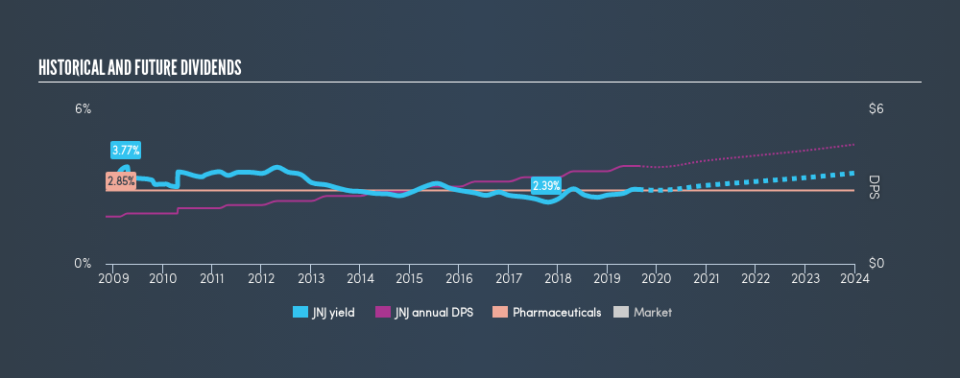3 Days Left Until Johnson & Johnson (NYSE:JNJ) Trades Ex-Dividend

Johnson & Johnson (NYSE:JNJ) is about to trade ex-dividend in the next 3 days. This means that investors who purchase shares on or after the 26th of August will not receive the dividend, which will be paid on the 10th of September.
Johnson & Johnson's next dividend payment will be US$0.95 per share, on the back of last year when the company paid a total of US$3.80 to shareholders. Calculating the last year's worth of payments shows that Johnson & Johnson has a trailing yield of 2.9% on the current share price of $131.53. Dividends are an important source of income to many shareholders, but the health of the business is crucial to maintaining those dividends. So we need to check whether the dividend payments are covered, and if earnings are growing.
See our latest analysis for Johnson & Johnson
Dividends are usually paid out of company profits, so if a company pays out more than it earned then its dividend is usually at greater risk of being cut. Johnson & Johnson paid out more than half (60%) of its earnings last year, which is a regular payout ratio for most companies. Yet cash flows are even more important than profits for assessing a dividend, so we need to see if the company generated enough cash to pay its distribution. Over the last year it paid out 53% of its free cash flow as dividends, within the usual range for most companies.
It's encouraging to see that the dividend is covered by both profit and cash flow. This generally suggests the dividend is sustainable, as long as earnings don't drop precipitously.
Click here to see the company's payout ratio, plus analyst estimates of its future dividends.
Have Earnings And Dividends Been Growing?
Stocks in companies that generate sustainable earnings growth often make the best dividend prospects, as it is easier to lift the dividend when earnings are rising. If earnings fall far enough, the company could be forced to cut its dividend. With that in mind, we're encouraged by the steady growth at Johnson & Johnson, with earnings per share up 4.4% on average over the last five years. Earnings growth has been slim and the company is paying out more than half of its earnings. While there is some room to both increase the payout ratio and reinvest in the business, generally the higher a payout ratio goes, the lower a company's prospects for future growth.
The main way most investors will assess a company's dividend prospects is by checking the historical rate of dividend growth. In the past 10 years, Johnson & Johnson has increased its dividend at approximately 7.5% a year on average. We're glad to see dividends rising alongside earnings over a number of years, which may be a sign the company intends to share the growth with shareholders.
To Sum It Up
Has Johnson & Johnson got what it takes to maintain its dividend payments? Earnings per share have been growing modestly and Johnson & Johnson paid out a bit over half of its earnings and free cash flow last year. While it does have some good things going for it, we're a bit ambivalent and it would take more to convince us of Johnson & Johnson's dividend merits.
Ever wonder what the future holds for Johnson & Johnson? See what the 19 analysts we track are forecasting, with this visualisation of its historical and future estimated earnings and cash flow
A common investment mistake is buying the first interesting stock you see. Here you can find a list of promising dividend stocks with a greater than 2% yield and an upcoming dividend.
We aim to bring you long-term focused research analysis driven by fundamental data. Note that our analysis may not factor in the latest price-sensitive company announcements or qualitative material.
If you spot an error that warrants correction, please contact the editor at editorial-team@simplywallst.com. This article by Simply Wall St is general in nature. It does not constitute a recommendation to buy or sell any stock, and does not take account of your objectives, or your financial situation. Simply Wall St has no position in the stocks mentioned. Thank you for reading.

